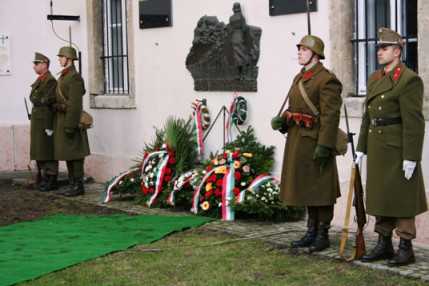We Suffered The Fourth Greatest Loss
Szöveg: Andrea Kánya | 2010. január 18. 11:20The program series entitled ‘Remembering Don Heroes’ was launched on December 12 at the Institute and Museum of Military History. As the first stage of the program a commemoration and a wreath-laying ceremony were held on Tuesday, in the framework of which the 1940M Nimród armored vehicle and the 1936M Bofors 40 mm anti-aircraft automatic gun were also presented.
In January 1943, the Royal Hungarian 2nd Honvéd Army engaged in fierce fights in the eastern theater. The 3rd army corps, first deployed in the area of Orjol and Kursk, got to the first lime almost immediately and advanced towards Voronezh, right up to the River Don. The troops arrived to the Don after a long march.
After marching more than a thousand kilometers, the soldiers had to realize that due to the lack of ammunition, food and clothing, the bad equipments, biting cold, the number of casualties and the exhausted troops, there was only a little chance for victory. The powerful Soviet attack broke the Hungarian resistance – the 2nd Honvéd Army suffered huge losses: of the 200,000-strong army some 40 thousand troops fell and 70 thousand were taken prisoners.
At the event held on the occasion of the 67th anniversary of the breakthrough at the Don, the heroes, survivors, troops killed in action, disabled soldiers, and the victims were commemorated with military honours and the tribute of heritage groups.

The first day of the program series started with a morning memorial mass held in the Nagyboldogasszony Church in the Buda Castle. After the mass, the morning continued with commemorating the Don heroes in the courtyard of the Institute and Museum of Military History. After the Hungarian national anthem actor Sándor Németh recited a poem, then retired Lieutenant General Dr. József Holló, the general director of the Institute and Museum of Miltary History delivered a speech. The general director began with saying that there is not a family in Hungary that had not lost a father, a son, a brother or a relative in the war. “The first sad recording of our soldiers who survived the Don could start in 1990, the same year when the idea of a commemorative journey to the Don theater came up. The period following the lost war did not make it possible for nearly half a century to mourn our soldiers killed in action and our civilian victims of the Second World War" – said Dr. József Holló, who also mentioned that the cemetery of reconciliation between Beregszász and Munkács will be inaugurated in 2010, hopefully. The complex, that is an international, central military cemetery, is built in Ukrainian-Hungarian cooperation and it is called ‘Reconciliation For A Common Europe’.
Like Dr. Holló said, not only the tragic events are remembered. “This commemoration, that is the twentieth already, is also the self-examination of the role of Hungary in the Second World War and our behavior during the great war, and last but not least, the memorial day of the honour, heroism, and honesty of the Hungarian soldier." Dr. József Holló also called attention to the losses suffered at the Don. Like he said, the Hungarian troops fought an unequal battle in bitter cold. They fought with the available weapons that were often inadequate and they had only a few winter clothes, but kept their oath even if they had to sacrifice their lives. “In nearly one year, during its operation, the 2nd Hungarian Army lost approximately 125 thousand soldiers and forced labourers in the theaters of operation, and these men were either taken prisoners of war, or disappeared forever. More than fifty thousand people were killed in action in the Second World War – Hungary was fourth as regards the number of casualties; the country had lost 800 thousand people, of which 350 thousand were soldiers" – said the general director.
Following the speech of Dr. József Holló, field bishops Dr. László Bíró and Brigadier General Dr. Pál Lakner said a prayer of condolence in remembrance of the heroes.

At the ceremony Lieutenant Colonel Dr. Imre Csáky, the senior scientific officer of the MoD Institute and Museum of Military History told the guests about the Don Heroes Memorial Tour of the Association of Hungarian Reservists, then those members of the Royal Hungarian 2nd Honvéd Army who are still with us presented the Heritage Group of the Royal Hungarian 106th Independent Honvéd Anti-Aircraft Automatic Gun Battery with division colours with a pattern from 1938.
The presentation of the colours was followed by a wreath-laying ceremony and the consecration of the colours. The 10th Don Memorial Tour departed after the ceremony, and the guests could take a look at the Nimród armored vehicle, introduced in the Hungarian People’s Army in 1940, and the BOFORS anti-aircraft automatic gun that had proven its excellence in the Spanish civil war. The military technology demonstration was held by the heritage groups.